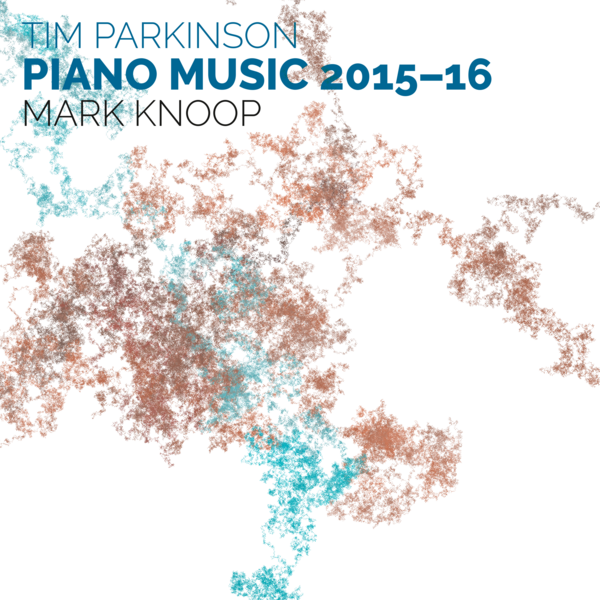
Tim Parkinson
Piano music 2015-16
Mark Knoop
atd6
The piano pieces on this recording were composed between the summer of 2015 and the end of 2016. Tim Parkinson’s personal history with the instrument, and the way his music sometimes alights on familiar figurations or scatters them, feeds into bigger questions about what it means to continue to write piano music in the twenty-first century.
Critical acclaim
[…] there is craft in abundance on this disc. piano piece 2015 and we’ll meet again from the same year sandwich seven prosaically-titled 2016 works, presenting a cornucopia of musical ideas and techniques. […] More than a diary or sketches, each piece reflects a musical mind contemplating and reconsidering music, as played and heard upon the piano.
Tim Parkinson has toggled nonchalantly between experimental performance pieces and scored music, all of it investigating the meaning of sound. Mark Knoop sensitively explores that latter material on Piano Music 2015-2016, a set of often-austere solo works arriving as discrete studies that feel obliquely connected.
Tracks
| 1 | piano piece 2015 | 17:45 |
| 2 | 2016 No.1 | 8:45 |
| 3 | 2016 No.2 | 4:36 |
| 4 | 2016 No.3 | 3:37 |
| 5 | 2016 No.4 | 4:22 |
| 6 | 2016 No.5 | 2:57 |
| 7 | 2016 No.6 | 4:31 |
| 8 | 2016 Last Piece | 2:43 |
| 9 | we’ll meet again | 14:14 |
| TT | 63:31 |
Liner notes
The piano pieces on this recording were composed between the summer of 2015 and the end of 2016. Parkinson’s only works for other instruments during this time were Duet for Deborah and Silvia (for violin and cello) and string quartet 2016. The compositional chronology and the concentration on the piano is significant, because it suggests that ideas lead from one piece to the next. Yet those links are not always clear, but rather submerged or extracted. Parkinson likens a finished piece to the end of a tunnel, stretching from one point of time to another and leaving scant trace of the discarded remnants of work in between. The distances and differences between works might seem large as a result, but there are subterranean, long-term, deeply thought continuities.
On the whole, Parkinson’s titles, which are always decided after completion, are factual labels rather than descriptive images that might over-determine what is heard. Thus, piano piece 2015 was composed in the autumn of that year. Awareness of time passing is key to understanding what these pieces are about. On one level, they seem to track the passing of the seasons, moving twice from summer to winter (from 2015’s we’ll meet again to 2016 No.1 and then from 2016 No.2 to 2016 Last Piece). They might then be heard like entries in a diary, which can be compared to note the differences between years: what artistic fruits were appearing? In what cultural or political context? On another level, it is evident that increasingly close attention is paid to musical material: the repeated pitches in 2016 No.1, for instance, are examined as if under a microscope. Perhaps as a result of that focus, the pieces become gradually shorter and denser, seeming to step their way from the fragile introspection of piano piece 2015 to the diverse and colourful pieces of 2016.
Parkinson often refers to his music in tactile and spatial terms, as sound-shapes, sound-masses and strata; piano piece 2015 is said to have ‘a very worked surface’ and he describes the piano pieces as ‘sculpted from images relating to the piano, both the sound of it, and the inescapable kinetic inheritance of hands at the piano, mine of which have played piano music for the last forty years’. That sense of personal history with the instrument, and the way the music sometimes alights on familiar figurations or scatters them, feeds into bigger questions about what it means to continue to write piano music in the twenty-first century.
Though placed last on the disc, we’ll meet again predates the other pieces and, in contrast to the numbered pieces, has a richly referential title. The song ‘We’ll Meet Again’, famously recorded by Vera Lynn in 1939, is an embodiment of wishing for continuity amidst the awareness of overwhelming finality. As Parkinson explains: ‘This piece is really an attempt to grab an entire piano sound, all the notes at once, thick encrusted chords, rich anonymous non-harmony, and it felt like a farewell to the piano, or to piano literature. So the title feels a bit flippant to me (although I was thinking that it would serve in a similar way to Beckett’s Happy Days).’ In this snapshot of Parkinson’s work, then, we end by looking back at the piece that seems to slam shut one chapter only, inevitably, to launch the next. An ending, but we know there is more to come.
Laura Tunbridge